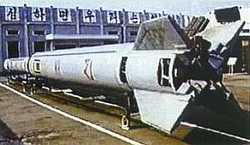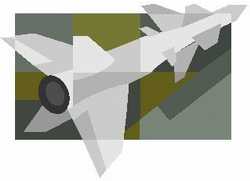 Faced with the threat by North Korea of a nuclear
warhead's reaching the United States, senior Pentagon officials
told the House Armed Services Committee March 20 they are moving
forward with a billion-dollar missile defense system.
Faced with the threat by North Korea of a nuclear
warhead's reaching the United States, senior Pentagon officials
told the House Armed Services Committee March 20 they are moving
forward with a billion-dollar missile defense system.
"We have achieved a number of successes in the missile defense
test program, which have added momentum to the development effort
and bolstered our confidence that we will be able to meet the
challenges that lie ahead," Edward E. "Pete" Aldridge Jr.,
undersecretary of defense acquisition, technology and logistics,
told the committee.
Aldridge, joined on Capitol Hill by Thomas Christie, DoD
director of operational test and evaluation, and J.D. Crouch II
(below, right), assistant secretary of defense for international
security policy, testified on the progress of a missile defense
testing facility in Alaska and on U.S. missile defense policy.
Last year, President Bush ordered the Pentagon to field a "hit
to kill" missile defense capability by the year 2004. The United
States currently has no defense against long-range missiles and
limited defense against shorter-range missiles.
Aldridge said the Pentagon's confidence in the program lies in
tests done by the Missile Defense Agency, which has oversight of
the program. Those tests, although criticized as being highly
controlled, show promising results despite several misses.
 In September, an Aegis sea-based theater defense
radar aboard the cruiser USS Lake Erie was able to track all stages
of a Minuteman III ICBM launched from Vandenberg Air Force Base,
Calif. In October, the Navy destroyer USS John Paul Jones used its
Aegis radar system in a test to track long-range target ballistic
missile.
In September, an Aegis sea-based theater defense
radar aboard the cruiser USS Lake Erie was able to track all stages
of a Minuteman III ICBM launched from Vandenberg Air Force Base,
Calif. In October, the Navy destroyer USS John Paul Jones used its
Aegis radar system in a test to track long-range target ballistic
missile.
Overall, MDA has recorded four successful tests of out five for
the long-range ground-based intercepts, and was three-for-three for
the short- to medium-range sea-based intercepts. The agency was
five out of seven for short-range ground-based intercepts, Crouch
said.
"When tests have failed, we understand what went wrong and have
taken measures to correct the problem," Crouch said. "Some test
failures are to be expected with advanced technology development
programs."
But the Pentagon cannot afford to fail in this program. North
Korea has had an active ballistic missile program for years, Crouch
testified.
"North Korea caught us by surprise when it launched its
three-stage Taepo-Dong I space-launch vehicle/ballistic missile in
August 1998," he said. Now, he said, the Taepo Dong II long-range
missile is capable of delivering a nuclear weapon-sized payload to
parts of the United States and "could be flight-tested at any
time," he noted.
Crouch said that, according to the National Air Intelligence
Center, the Taepo Dong II (below, right) missile might be exported
to other countries in the future. Also, Iran and other countries
also are working on space-launch vehicles and
intercontinental-range ballistic missiles that could be ready for
testing in the next few years, he said.
 "We knew North Korea was developing longer-range
missiles, but we were surprised at the presence of a third stage on
the missile," Crouch explained. "We have been surprised many times
in the past by foreign ballistic missile developments. We likely
will be surprised again in the future," he added. The problem for
the Pentagon is that some in Congress believe the military is
moving forward too fast on a costly, unproven missile defense
system.
"We knew North Korea was developing longer-range
missiles, but we were surprised at the presence of a third stage on
the missile," Crouch explained. "We have been surprised many times
in the past by foreign ballistic missile developments. We likely
will be surprised again in the future," he added. The problem for
the Pentagon is that some in Congress believe the military is
moving forward too fast on a costly, unproven missile defense
system.
Christie said that he "understands and shares concerns raised by
members of Congress" regarding the precedent of field operational
systems without adequate testing. But he told the committee the
Missile Defense Agency must move forward with completion of the
test bed to further missile defense development.
"If we don't develop an operational concept and an attack comes,
then we will have failed in a most serious way," he told the
committee. The Missile Defense Agency says it will cost $7.7
billion and $8.7 billion over the next two fiscal years and about
$8 billion a year thereafter to run the program. The Pentagon began
building a missile defense test site in Alaska last summer. It is
scheduled for completion next year.
The Pentagon missile defense plan calls for 20 ground-based
interceptors to protect against an intercontinental-range ballistic
missile threat. Those missiles will be stored in silos at Fort
Greeley, Alaska, and at Vandenberg.
Crouch said the United States has asked the United Kingdom and
Denmark for permission to upgrade early warning radars in their
countries to track ballistic missile threats from the Middle East.
"The U.K. has granted permission, and we look forward to hearing
from Denmark later this year," he said.
 To address the medium-range threat, Crouch said
three Navy Aegis-class ships will be equipped with up to 20 SM-3
Standard missiles. "This will provide a highly mobile missile
defense capability to help protect U.S. forces and allies and
provide some limited protection for the U.S. homeland against
shorter-range missiles launched from ships off our coasts," Crouch
said.
To address the medium-range threat, Crouch said
three Navy Aegis-class ships will be equipped with up to 20 SM-3
Standard missiles. "This will provide a highly mobile missile
defense capability to help protect U.S. forces and allies and
provide some limited protection for the U.S. homeland against
shorter-range missiles launched from ships off our coasts," Crouch
said.
For short-range threats, Crouch said that Army would continue to
field additional air-transportable and mobile Patriot Advanced
Capability-3 missile units with up to 346 PAC-3 missiles and 42
PAC-3 radars. The PAC-3 missile is the first upgrade of the Patriot
system to feature a "hit to kill" missile that can help defeat
chemical and biological threats.
[Thanks to Sgt. 1st Class Doug Sample, USA, American Forces Press
Service --ed.]
 Aero-News: Quote of the Day (10.24.25)
Aero-News: Quote of the Day (10.24.25) ANN's Daily Aero-Linx (10.24.25)
ANN's Daily Aero-Linx (10.24.25) NTSB Final Report: Cirrus SR22
NTSB Final Report: Cirrus SR22 Airborne-Flight Training 10.23.25: PanAm Back?, Spirit Cuts, Affordable Expo
Airborne-Flight Training 10.23.25: PanAm Back?, Spirit Cuts, Affordable Expo Airborne 10.22.25: Rez Takes Plane, DJI v US Drone Ban, HK 747 Cargo Accident
Airborne 10.22.25: Rez Takes Plane, DJI v US Drone Ban, HK 747 Cargo Accident






